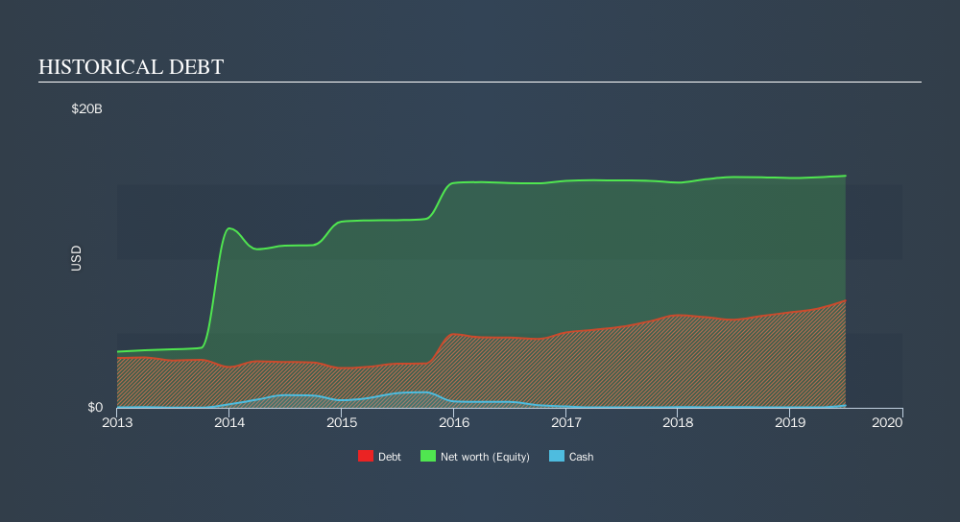These 4 Measures Indicate That Avangrid (NYSE:AGR) Is Using Debt Extensively

The external fund manager backed by Berkshire Hathaway's Charlie Munger, Li Lu, makes no bones about it when he says 'The biggest investment risk is not the volatility of prices, but whether you will suffer a permanent loss of capital. So it might be obvious that you need to consider debt, when you think about how risky any given stock is, because too much debt can sink a company. We note that Avangrid, Inc. (NYSE:AGR) does have debt on its balance sheet. But is this debt a concern to shareholders?
When Is Debt Dangerous?
Debt is a tool to help businesses grow, but if a business is incapable of paying off its lenders, then it exists at their mercy. In the worst case scenario, a company can go bankrupt if it cannot pay its creditors. However, a more common (but still painful) scenario is that it has to raise new equity capital at a low price, thus permanently diluting shareholders. Having said that, the most common situation is where a company manages its debt reasonably well - and to its own advantage. The first thing to do when considering how much debt a business uses is to look at its cash and debt together.
Check out our latest analysis for Avangrid
What Is Avangrid's Net Debt?
The image below, which you can click on for greater detail, shows that at June 2019 Avangrid had debt of US$7.19b, up from US$5.91b in one year. However, it does have US$166.0m in cash offsetting this, leading to net debt of about US$7.02b.
How Healthy Is Avangrid's Balance Sheet?
Zooming in on the latest balance sheet data, we can see that Avangrid had liabilities of US$2.81b due within 12 months and liabilities of US$14.8b due beyond that. Offsetting this, it had US$166.0m in cash and US$1.02b in receivables that were due within 12 months. So its liabilities total US$16.4b more than the combination of its cash and short-term receivables.
Given this deficit is actually higher than the company's massive market capitalization of US$15.9b, we think shareholders really should watch Avangrid's debt levels, like a parent watching their child ride a bike for the first time. In the scenario where the company had to clean up its balance sheet quickly, it seems likely shareholders would suffer extensive dilution.
We use two main ratios to inform us about debt levels relative to earnings. The first is net debt divided by earnings before interest, tax, depreciation, and amortization (EBITDA), while the second is how many times its earnings before interest and tax (EBIT) covers its interest expense (or its interest cover, for short). The advantage of this approach is that we take into account both the absolute quantum of debt (with net debt to EBITDA) and the actual interest expenses associated with that debt (with its interest cover ratio).
Avangrid's debt is 3.8 times its EBITDA, and its EBIT cover its interest expense 3.1 times over. Taken together this implies that, while we wouldn't want to see debt levels rise, we think it can handle its current leverage. More concerning, Avangrid saw its EBIT drop by 6.5% in the last twelve months. If that earnings trend continues the company will face an uphill battle to pay off its debt. There's no doubt that we learn most about debt from the balance sheet. But ultimately the future profitability of the business will decide if Avangrid can strengthen its balance sheet over time. So if you're focused on the future you can check out this free report showing analyst profit forecasts.
Finally, while the tax-man may adore accounting profits, lenders only accept cold hard cash. So the logical step is to look at the proportion of that EBIT that is matched by actual free cash flow. During the last three years, Avangrid burned a lot of cash. While that may be a result of expenditure for growth, it does make the debt far more risky.
Our View
Mulling over Avangrid's attempt at converting EBIT to free cash flow, we're certainly not enthusiastic. And even its net debt to EBITDA fails to inspire much confidence. It's also worth noting that Avangrid is in the Electric Utilities industry, which is often considered to be quite defensive. We're quite clear that we consider Avangrid to be really rather risky, as a result of its balance sheet health. So we're almost as wary of this stock as a hungry kitten is about falling into its owner's fish pond: once bitten, twice shy, as they say. Another positive for shareholders is that it pays dividends. So if you like receiving those dividend payments, check Avangrid's dividend history, without delay!
At the end of the day, it's often better to focus on companies that are free from net debt. You can access our special list of such companies (all with a track record of profit growth). It's free.
We aim to bring you long-term focused research analysis driven by fundamental data. Note that our analysis may not factor in the latest price-sensitive company announcements or qualitative material.
If you spot an error that warrants correction, please contact the editor at editorial-team@simplywallst.com. This article by Simply Wall St is general in nature. It does not constitute a recommendation to buy or sell any stock, and does not take account of your objectives, or your financial situation. Simply Wall St has no position in the stocks mentioned. Thank you for reading.

